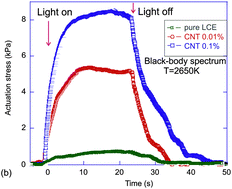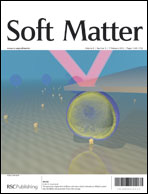Carbon-nanotube sensitized nematic elastomer composites for IR-visible photo-actuation
Abstract
Liquid crystal elastomers (LCEs) are of considerable interest for their potential as actuators, due to the ability of aligned monodomain LCEs to reversibly change their bulk dimensions in response to a phase change. Many LCEs reported in the literature will contract in one dimension in response to a temperature change or irradiation with ultraviolet light. For practical applications, photo-actuation is a more useful technology than thermal actuation due to the achievable speed and localization of the response. The use of UV light sources to ‘switch’ the materials is impractical, however, due to considerations of both safety and cost. Sensitization of LCEs to light of higher wavelengths may be achieved by


 Please wait while we load your content...
Please wait while we load your content...